SWEDISH SOUTH ASIAN STUDIES NETWORK
Reflections from the Seminar |
Beyond Control – Risk and Learning After the Tsunami |
held at Lund University, Monday 11 april 2005, 13–21.
|
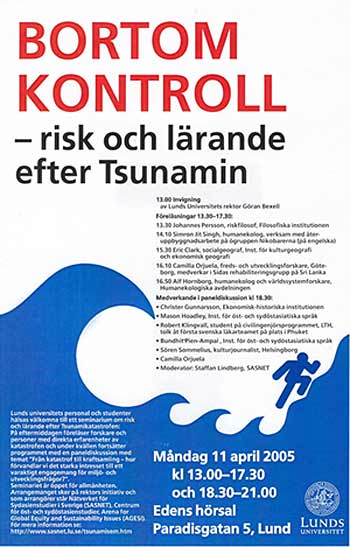 Summary
by Sabina Andrén, AGESI:
Summary
by Sabina Andrén, AGESI:
After the earthquake and the tsunami in the Indian Ocean, Lund University’s
Vice-Chancellor Göran Bexell
appointed a working group to propose how the university could
pay attention to the natural disaster.
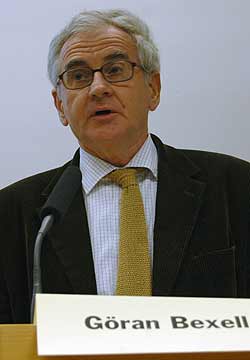 |
One of the suggestions was to organise an open seminar where researchers and other experts would give their view on risks and learning based on the Tsunami disaster. This seminar was held on Monday 11 April 2004. Collaborating partners to arrange this event was Swedish South Asian Studies Network (SASNET), Centre for East- and South-East Asian Studies and Arena for Global Equity and Sustainability Issues (AGESI).
The seminar was introduced by Vice-Chancellor Göran Bexell himself. In his speech he described the seminar as a part of Lund University’s profile on global sustainable development. He also underlined the importance of interdisciplinary meetings and co-operation between faculties on this subject.
Concepts of risk and control
Johannes Persson, Associate
Professor at Lund University’s Department
of Philosophy, was the first speaker in the afternoon session.
As a philosopher he elaborated on ”The concepts
of risk and control”. What people consider as a risk depends
not only on the specific object that is concerned, but also on the possibilities
of risk management and protection from this risk object.
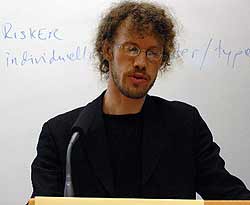 When the person or the society has total control, then the risk is zero.
On the opposite, when there are no possibilities to influence the course
of events at all, risk has changed into destiny. It is between these polarities
we, as individuals and as societies, are forced to live. We also have
to separate between two types of risks: risks as general categories and
risks as individual events. When the Tsunami reached the shores of the
Indian Ocean, it could no longer be considered as a risk, because it was
already an actual and on-going event that couldn't be controlled.
When the person or the society has total control, then the risk is zero.
On the opposite, when there are no possibilities to influence the course
of events at all, risk has changed into destiny. It is between these polarities
we, as individuals and as societies, are forced to live. We also have
to separate between two types of risks: risks as general categories and
risks as individual events. When the Tsunami reached the shores of the
Indian Ocean, it could no longer be considered as a risk, because it was
already an actual and on-going event that couldn't be controlled.
For the individuals who were hit by the Tsunami, we can no longer speak
of risk, but of a fact. But if we look at Tsunamis as a general phenomenon,
then they are certainly a risk, because the individual as well as the
society can make choices that will create different risk images. For example,
a Tsunami warning system or other precautionary measures for those living
very near to shore, would have reduced the risk for Tsunamis as general
phenomena. One of the things that we can learn from the Tsunami in 2004,
is that while we as individuals to some extent can reduce our exposure
to risk, political and collective actions of risk management are very
important. At the same time even modern societies and individuals as modern
persons have to live with the fact that risks will always exist and can
never be completely controlled.
Nicobar Islands worst affected
The next speaker was Simron jit Singh,
Researcher and Lecturer at the Institute
of Social Ecology, University of Klagenfurt in Vienna. Singh defended
his PhD at the Department of Human Ecology in Lund on ecological unequal
exchange using the Nicobar Islands in the Bay of Bengal as a case (more
information on his dissertation). The Nicobars, part of the Indian
Union territory of the Andaman and Nicobar Islands, are largely inhabited
by an indigenous community called the Nicobarese. They were heavily affected
by the Tsunami.
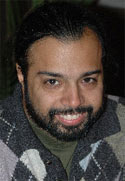 Simron, who spoke on the effects of the Tsunami
to the Nicobar Islands, arrived to the seminar straight from the
Nicobar Islands, where he had been working with the local Tribal Council
in the first phase of rehabilitation and reconstruction after the Tsunami.
Emotionally affected and upset by the effects of the natural disaster,
Singh showed unique photographs from the totally devastated islands. Being
close to the epicentre and with people living on the coastal zones were
one of the most severely affected areas in the Indian Ocean. Nearly one
third of the inhabitants were swept away by the waves, while the surviving
are left homeless, propertyless, and without an economy to support them.
Simron, who spoke on the effects of the Tsunami
to the Nicobar Islands, arrived to the seminar straight from the
Nicobar Islands, where he had been working with the local Tribal Council
in the first phase of rehabilitation and reconstruction after the Tsunami.
Emotionally affected and upset by the effects of the natural disaster,
Singh showed unique photographs from the totally devastated islands. Being
close to the epicentre and with people living on the coastal zones were
one of the most severely affected areas in the Indian Ocean. Nearly one
third of the inhabitants were swept away by the waves, while the surviving
are left homeless, propertyless, and without an economy to support them.
The Nicobarese economy, prior to the Tsunami, was largely subsistent,
derived by hunting and gathering, fishing and the export of copra (dehydrated
coconut) in exchange for rice, cloth and other daily commodities. Singh’s
description of the national and international assistance was very critical.
The Indian authorities were very slow to undertake rescue and deliver
relief to the affected people on the islands. Insensitive interventions,
lack of co-ordination, and little understanding of the special cultural
and ecological context have been serious problems in the post tsunami
phase. Indigenous leaders played a vital role in the rescue operations,
while state representatives and NGO officials operated with different
logics and means. According to Singh, the NGOs are involved in a kind
of ‘bidding ground’ to the assistance activities.
In this ‘Eden for NGO’s”, a peculiar ‘market place’
for state and NGO competition has also emerged. While the whole process
of rehabilitation and reconstruction has been stalled by these conflicts,
Singh puts hope in the work of the local tribal council, that attempts
to coordinate a comprehensive reconstruction plan for the Nicobar Islands
to be developed in consultation with the people. The plan aims to rebuild
the unique culture and livelihood of the islands without destroying traditional
forms of self-reliance, the social system and local leadership, and the
ecologically sustainable management of the natural resources of the islands.
 Eric
Clark, Professor at Lund University’s Department
of Social and Economic Geography, spoke about: ‘The
Second Wave – Beyond Control?’ As a researcher in Social
Geography he has paid special attention to processes of gentrification,
which involve shifts in land use and displacement of land users associated
with redevelopment. One example is the way attractive areas on tropical
islands are bought by socio-economically powerful groups whose visions
of hotels, restaurants and luxurious residencies stand in stark contrast
to the visions of present land-users. Gentrification is a general and
worldwide phenomenon. Poor and marginalized groups are unsettled from
their homelands by a process of market economy logics and the strength
of those who have access to capital and power.
Eric
Clark, Professor at Lund University’s Department
of Social and Economic Geography, spoke about: ‘The
Second Wave – Beyond Control?’ As a researcher in Social
Geography he has paid special attention to processes of gentrification,
which involve shifts in land use and displacement of land users associated
with redevelopment. One example is the way attractive areas on tropical
islands are bought by socio-economically powerful groups whose visions
of hotels, restaurants and luxurious residencies stand in stark contrast
to the visions of present land-users. Gentrification is a general and
worldwide phenomenon. Poor and marginalized groups are unsettled from
their homelands by a process of market economy logics and the strength
of those who have access to capital and power.
‘The second wave of risk comes when what is disaster for one person,
becomes an opportunity for another’ Eric Clark pointed out. What
will happen on the islands and coastlands of the Indian Ocean? Will the
local and small scale fishing populations be driven away to be replaced
by tourist hotels and recreation areas for the urban rich? Is this kind
of process a necessary evil, the price for ‘development’ in
these often relatively poor countries of the region? There are evidently
many ‘top-down’ measures and signs of gentrification in the
‘post Tsunami phase’. But Eric Clark also directed the seminar
participants’ attention to other actors that do not represent large
scale and financially strong interests. The reconstruction of the shores
and islands of the Bay of Bengal is not without opportunity for these
groups. But at the same time, the ‘colonial presence’ and
the huge inequalities with regard to access to power and capital is a
threat to socially and culturally as well as ecologically sustainable
post Tsunami reconstruction.
War or peace in Sri Lanka after the Tsunami?
 Next
speaker was Camilla Orjuela,
Researcher at the Department of Peace and Development
Research (PADRIGU) at Göteborg University. She had recently returned
from a month’s visit to Sri Lanka where she took part in a study
organized by the Sri Lankan government and international donors on how
to implement post-tsunami reconstruction. The east and south coasts of
Sri Lanka were severely hit by the Tsunami. About 30 000 people died and
whole areas were devastated.
Next
speaker was Camilla Orjuela,
Researcher at the Department of Peace and Development
Research (PADRIGU) at Göteborg University. She had recently returned
from a month’s visit to Sri Lanka where she took part in a study
organized by the Sri Lankan government and international donors on how
to implement post-tsunami reconstruction. The east and south coasts of
Sri Lanka were severely hit by the Tsunami. About 30 000 people died and
whole areas were devastated.
Rebuilding Sri Lanka is dual challenge Besides the massive reconstruction,
there is also the conflict between the government and the Tamilian forces
in the north and east part of the country to take into consideration.
Camilla Orjuela gave a detailed report about the
current situation in Sri Lanka, a situation which unfortunately
shows slow progress in moving from first aid assistance to long term reconstruction
and rehabilitation. Local people experience a lack of information and
opportunity to influence the process. The Sri Lankan government exercises
a centralized power from the capital in the south west.
In combination with the political conflict this adds another problem to
an already vague democratic situation. If the properties and houses lost
in the Tsunami are to be compensated for, will this also be the case for
property and houses destroyed and lost because of the conflict? What is
the reconstruction of the coast near villages going to look like? What
is to be rebuilt and on what level of material standards? What kind of
‘development’ will be implemented in the post Tsunami reconstruction
of Sri Lanka? Camilla Orjuela gave a disturbing picture of the struggle
between national and international actors and their large scale plans
on the one hand, and the local and small-scale population that must live
with the consequences on the other.
How westerners reacted to the effects
 The
last speaker in the afternoon session was
Alf Hornborg, Professor at the Human
Ecology Division. As a cultural anthropologist and world system researcher,
Hornborg presented some reflections on how we, as
modern persons in the industrialized Western countries, reacted on the
effects of the Tsunami. While as a seismic sea-wave it was obvious
on our TV-screens, it also created what could be called ‘an emotional
tidal wave’ in the global community, comparable to that following
9/11. Our perceptions of identity and security were fundamentally shaken.
How could this disaster happen? Was nature really so beyond control? And
as Europeans and especially Swedish tourists were among the victims: how
could this be allowed to happen to our own relatives and friends?
The
last speaker in the afternoon session was
Alf Hornborg, Professor at the Human
Ecology Division. As a cultural anthropologist and world system researcher,
Hornborg presented some reflections on how we, as
modern persons in the industrialized Western countries, reacted on the
effects of the Tsunami. While as a seismic sea-wave it was obvious
on our TV-screens, it also created what could be called ‘an emotional
tidal wave’ in the global community, comparable to that following
9/11. Our perceptions of identity and security were fundamentally shaken.
How could this disaster happen? Was nature really so beyond control? And
as Europeans and especially Swedish tourists were among the victims: how
could this be allowed to happen to our own relatives and friends?
At the same time as feelings of deep distress and dismay are understandable,
there are also some important lessons to be learned from the Tsunami.
Firstly, nature has other features than just being a relaxing domain for
leisure and consumption. Nature is not only beautiful and enjoyable, but
frightening and wild. Even if human beings have made progress in the exploitation
of almost every single ecosystem on the planet, nature remains inherently
beyond our control. Secondly, the Tsunami uncovered what Hornborg called
the political geography of security.
Even if the wealthy nations of the so-called North are expected to provide
welfare and security for their citizens, increasing mobility in a globalized
world has made it more difficult to keep danger out (witness 9/11) and
to keep citizens securely at home. Moreover, the prosperity of these nations
is intimately linked to a world system of unfair distribution of resources
and unequal trade relations. The technological security offered by the
welfare state can thus only be local. Globally we can expect increasing
levels of insecurity, often as the flip side of the North’s technological
struggles to increase security at home.
Panel discussion
The seminar ended with a panel discussion between researchers and persons
with experiences from the Tsunami catastrophe. Staffan
Lindberg, Professor at the Department
of Sociology (and Director for SASNET) and moderator of the seminar,
introduced the theme of the evening discussion: ”From
Disaster to Mustering of Strength. How Do We Transform the Strong Interest
into a Strong Commitment for Environmental and Development Issues?”
Staffan raised some questions for the panel and the audience to discuss:
What can we learn from the Tsunami and perhaps do better in the future?
What possibilities are there to strengthen and co-ordinate efforts in
support of an ecologically and socially sustainable development in the
region? Some answers to these questions, and others were discussed by
the panel and the audience. The panel members also gave a short presentation
of their view on lessons to be learned from the Tsunami.
Christer Gunnarsson, Professor at the Department of Economic History, advocated the need for faster and stronger development in terms of increased wealth from economic growth and productivity. Even if the risk of unequal benefits from economic growth and increased production of goods and services has to be properly managed at a political level, the threat is not development, but rather the lack of development in many of these countries, according to Gunnarsson. It remains to be seen if the national authorities and the international community are able to monitor such a ‘positive development’ in the region.
 Mason
Hoadley, Professor at the Department
of East and South-East Asian Languages (photo to the right),
reported from Indonesia, one of the most affected countries in the region.
In the very poor and war-torn coastal areas north of Sumatra, the Aceh
region, the earthquake and the Tsunami almost completely destroyed the
social structure. The Indonesian government has launched an assistance
plan for relief, rehabilitation and reconstruction. But the implementation
has yet to take place, and there is also some doubt whether the huge amounts
of money will be spent on efficient and targeted assistance to the people.
Mason
Hoadley, Professor at the Department
of East and South-East Asian Languages (photo to the right),
reported from Indonesia, one of the most affected countries in the region.
In the very poor and war-torn coastal areas north of Sumatra, the Aceh
region, the earthquake and the Tsunami almost completely destroyed the
social structure. The Indonesian government has launched an assistance
plan for relief, rehabilitation and reconstruction. But the implementation
has yet to take place, and there is also some doubt whether the huge amounts
of money will be spent on efficient and targeted assistance to the people.
Mason Hoadley questioned whether the traditional political and administrative
bureaucracy is able to adopt the new ideas of ‘public management’,
for example to use methods for democratic participation, bottom-up policies
and transparency of information.
Joining the panel was Robert Klingvall,
student at Lund Institute of Technology and
often visiting Thailand as his mother and many relatives are Thai. Robert
Klingvall was in northern Thailand when the Tsunami hit the southern coasts.
He immediately went to the area and worked as an interpreter for a Swedish
medical team. Robert Klingvall gave an intimate and detailed picture of
the chaos and panic that characterized the situation in Phuket during
the first days after the Tsunami. He described the difficult work of the
medical team, and criticised media for not giving a comprehensive and
balanced picture of the very complex situation that faced the victims
and for those trying to assist and help.
 Bundhit
Pien, Lecturer at the Department of East
and South-East Asian Languages, also described the Thai situation
but from a social perspective. Tsunamis are nothing new in the history
and experience of the Thai people. And despite of the warnings that were
received from the Pacific Ocean Tsunami warning system some 75 minutes
before the actual tidal wave reached the coast lines of Thailand, no warnings
were sent out to the coast near local villages and tourist resorts.
Bundhit
Pien, Lecturer at the Department of East
and South-East Asian Languages, also described the Thai situation
but from a social perspective. Tsunamis are nothing new in the history
and experience of the Thai people. And despite of the warnings that were
received from the Pacific Ocean Tsunami warning system some 75 minutes
before the actual tidal wave reached the coast lines of Thailand, no warnings
were sent out to the coast near local villages and tourist resorts.
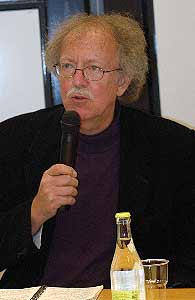 Are the Thai people risk loving and believers in fate? Or is it a question
of a corrupt bureaucratic system that will risk anything except to threaten
the profitable tourist industry and the image of Thailand as a safe and
strong country? Bundhit Pien asked for correct data and for the true picture
of the whole course of events. He urgently requested Sweden and the international
community to demand transparent information from the Thai government on
the issue.
Are the Thai people risk loving and believers in fate? Or is it a question
of a corrupt bureaucratic system that will risk anything except to threaten
the profitable tourist industry and the image of Thailand as a safe and
strong country? Bundhit Pien asked for correct data and for the true picture
of the whole course of events. He urgently requested Sweden and the international
community to demand transparent information from the Thai government on
the issue.
Sören Sommelius,
writer and journalist at the Swedish newspaper Helsingborgs Dagblad (photo
to the right), commented on the role of media. Western media covers
only the parts of the world which are connected to western economical
interests. So almost nothing was in the beginning reported from the Indian
east coast on the effects of the tsunami, as the consequences for multimillion
city Chennai. Small Scandinavian tourist resorts were heavily covered.
As Swedes we have a personal interest in the situation in the resorts,
but the bias was nevertheless obvious to every observer. Sören Sommelius
painted an alarming picture of the state of the media reports. Every day
around a hundred thousand humans die from hunger, poverty and diseases
that we have the possibility to cure. But these continuous disasters do
not create big headlines. Media, as well as the university, has an important
role to play in creating a true ‘global arena’ for information
and communication about the state of the world.
Sabina Andrén, AGESI
The post-Tsunami seminar was also covered by the regional newspapers: The journalist Stig Larsén wrote an article in Sydsvenskan on 12 April 2005, called ”Tsunamihjälp får skarp kritik”. Read his article (as a pdf-file, in Swedish).
Sören Sommelius, participant in the seminar himself, also wrote an article called ”Hur länge varar vårt intresse för offren?”, published in Helsingborgs Dagblad on Wednesday 13 April 2005. Read his article (as a pdf-file, in Swedish).
Finally the seminar was covered by Lund University’s journal Lunds Universitet Meddelar (LUM) in its 27 April issue. Read Ulrika Oredsson’s interview with Simron Jit Singh, an article called ”Fel hjälp kom till Nikobarerna” (as a pdf-file, in Swedish).
SASNET - Swedish South Asian Studies Network/Lund
University
Address: Scheelevägen 15 D, SE-223 70 Lund, Sweden
Phone: +46 46 222 73 40
Webmaster: Lars Eklund
Last updated
2006-01-27
